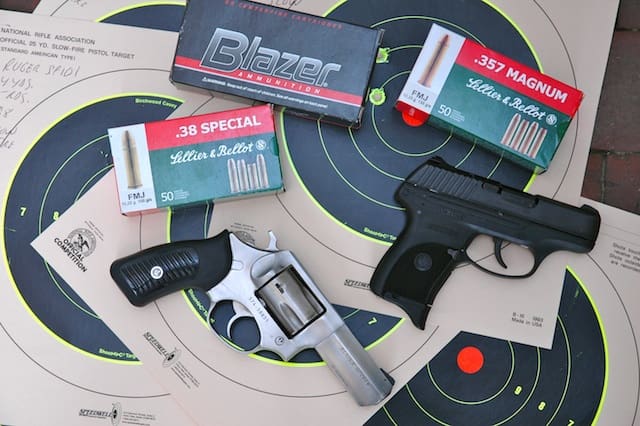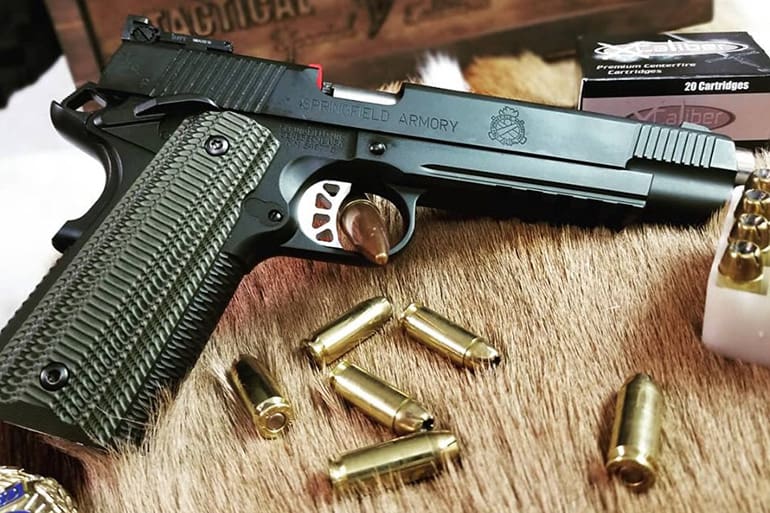Disclaimer: this experiment is to science what a Quarter Pounder with cheese is to haute cuisine. I make no claims as to its repeatability, applicability or accuracy. I simply noted the fact that I have two pocket-sized Rugers in my possession and decided to see which one was more accurate. Freehand. Shot by someone else (one must have some level of objectivity). At four yards. Slow and then rapid fire. To say your mileage may vary is something of an understatement—a rhetorical technique with which I have about as much familiarity as I do with identifying independent and dependent variables. In any case, here we go . . .
First up, my mustachioed FFL dealer Steven Fusco shooting the bone stock Ruger SP101 with a three-inch barrel, four yards, free hand, slow fire. I fed the gun Sellier & Bellot 158-grain .38 Special FMJ ammo. [Note: I chose the SP101 with a three-inch (3.06″) barrel for the gun’s alleged extra accuracy. Most people order the SP101 as a snubbie (2.25″).]
Steve is not a revolver guy, as witnessed by the fact that he stages the trigger. The SP101’s go-pedal is not as smooth as a Smith’s (comparo to follow), but it’s predictable enough. And it’s safe—even shooters severely lacking in the trigger discipline department are highly unlikely to create a negligent discharge. [Click here for TTAG’s SP101 review.]
The result: two shots in the ten ring, and three in the nine. That’s five shots for a total of 47 points. Combat sufficient fer sure. Next up: the Ruger LC9. [Click here for TTAG’s LC9 review.]
Steve had not fired the LC9 before. I warned him that it had a long trigger pull and told him to treat it like a revolver. This he did—for the first shot of Blazer 115 grain FMJ ammo. After that he was Broadway bound. Still, the results speak for themselves. Two in the ten ring, three in the nine, one in the eight and one in the seven. That’s seven shots for a total of 62 points.
If we’d gone seven plus one, the differential would have been even higher, obviously. And then there’s the fact that LC9 fires 9mm bullets, as compared to the SP101’s .38 Specials. There’s considerable debate about which cartridge contains a better man-stopper. Especially as the SP101’s 3″ barrel adds some of the “missing” velocity to this comparison.
Suffice it to say, shot placement and capacity are more important variables than the size and velocity differences. Unless . . .
Unless you’re firing .357 ammo (Sellier & Bellot 158 grain FMJ). That folks, is a serious self-defense round—even before you start looking at hollow point or fragmentation ammo designed for the job.
More good news: Steve’s accuracy didn’t suffer (much) when firing .357s from the heavyweight, 3″ Ruger SP101. Two in the ten ring, one in the nine, one in the eight and one in the seven. That’s a total of 42 points—only five less points than the same gun firing .38s.
Game, set match SP101 for self-defense? Nope. The LC9 wins for concealability. The SP101 wins for dependability (revolver, no safety). The LC9 wins for capacity. The Ruger SP101 wins for big ass bulletry. The LC9 wins for reloadability. The SP101 wins for idiot-proofery.
Also worth noting: the LC9 has far better sights than the SP101, which basically has none. Pop a Big Dot sight on the front end of the Ruger wheelgun and the results could be significantly different. (XS Sights are sending some for T&E.) Add a trigger job and some barrel porting to the SP101, and THEN who’s your Daddy? Price-wise, the LC9. But we shall see . . .
Meanwhile, I think I better think it through again—considering an oft-neglected aspect of self-defense shooting. Speed. Self-defense shooters SHOULD slow down and aim. But most don’t. So what happens when you shoot both weapons in spray and pray mode? Ruger LC9 first.
Huh. Three in the ten ring, one in the nine and, two in the seven and one in the five. That’s seven shots for a total of 58 points. That’s only four points down from slow-firing the same gun.
I attribute the LC9’s rapid-fire accuracy to the fact that the need-for-speed forced Steve to deploy the LC9’s looonnngggg trigger pull in one smooth motion. Even so, good deal. And now back to the SP101, firing .38s.
Whoa! I didn’t see that one coming. And if the bad guy does, there could be big trouble in little China. Steve hit the paper twice, once for seven and once for five. That’s a total of 12 points. Although I wouldn’t want to stand in front of any bullet, I rate that a combat effectiveness fail.
Make no mistake: modern revolvers are extremely accurate guns. But trigger control is all. When you start rushing things, that aspect of marksmanship quickly goes to shit. Keep in mind that four yards may be the average distance between a self-defense shooter and an attacker, but the gap could be considerably larger in a real life-or-death encounter.
Our main man Bo Wallace at XS Sights told TTAG that most cops start upping their shot pacing as soon as they see that they’re not achieving the desired result. As a result, they get less accurate with each shot. Leghorn’s testing the theory on our behalf, but the fundamental truth is clear: you have to train hard to shoot slowly and, thus, accurately.
So what happens if you add more recoil, via a higher-powered load, to a rapid-fire SP101? Here’s the same drill with the SP101 chambering .357s.
The accuracy results rapid-firing the SP101 3″ with .38s and .357s are identical. Same EXACT shot placement: one in the seven ring (high to the right) and one in the five ring (high to the left). Of course, the effect on the bad guy would not be similar; the .357 round can blow viscera clean through its target.
Conclusion? For concealed carry, if you’re not going to practice extensively or need a slimmer, lighter gun, the LC9 is the way to go. If you want to carry serious self-defense ammo, the SP101 with .357s on board is the better bet—provided you practice.
In both cases, in all cases, the key variable is time. No matter what the gun, slow down and live.
Next up: the same test with the Kimber Ultra Elite and Smith & Wesson Performance Center 67-5 Carry Comp. Does more money buy you more accuracy?





Fantastic! Unscientific? Yes. Reality is always unscientific. Revealing? Holy crap, yes! Who knew that the dinky pistol would hold its own against one of the finest SD revolvers around?
The whole stress plus speed equals inaccuracy thing is a very prevalent thing any gun owner should be wary of. Throw in an adrenaline fueled jacked up heart rate and anyone of us would have a hard time putting rounds on target.
Look, for example, at dashcam videos of routine traffic stops gone bad. LEO’s empty whole magazines in the general direction of their attacker and maybe score one or two hits.
Going from condition yellow to condition red or black in a matter of mere seconds is going to have an ill effect on every aspect of your thinking and motor skills. That’s why the old adage, “practice, practice, practice” is so important for anyone who carries a gun to defend themselves; muscle memory may be the one thing to save you.
Anywho, back on topic. Definitely one of the better and most revealing “unscientific” tests we’ve had here and who doesn’t love gratuitous youtubery?
How do you consider the SP101 a pocket gun? It looks to be roughly the size of an FN Five-seveN, and twice as wide.
I have big pockets. And although the SP101’s heavier than a FiveseveN, the lard ass Ruger’s recoil management is excellent for a .357. Which is a WAY better self-defense round than those needle-nosed FN bullets.
Of course you get almost five times as many bites at the cherry with the FN. But the FiveseveN’s grip is wider than the Grand Canyon. Well, the bit that Evil Knieval tried to jump.
I’ve rather have the Ruger—with better sights.
I wasn’t suggesting that the Five-seveN was a pocket gun, I was laughing at the idea that it or a 3″ SP101 could be!
Some SP101’s used to have adjustable sights. And they made them in .22LR, .32 H&Rmag, .38spl and .357mag.
Now, they make one .38 and four .357 models (all with fixed sights) and a single .327FedMag model with a 3″ barrel and adjustable sights.
Have to confess I am intrigued by the .327 FedMag, and not just because I have an unhealthy obsession with .30-bore handguns. Everyone who has reviewed the gun/cartridge combo says it is very controllable while offering significant power.
I have fired the .327 Federal SP101. It has a big flash, but the low recoil is almost enough to tempt me to buy a handgun that blows gas and debris out the sides…
I’d like to see a Ruger LCR 357 included in such a test, with 38spl +p and 357 ammo. A true CCW with a very good trigger and significant stopping power.
Just some remarks, not criticisms:
12 feet range
SP101 vid: aimed fire, 2 hands on gun, 2+ sec per shot.
LC 9 vid: aimed fire, 2 hands on gun, about 2 sec per shot.
SP 101 w. 357’s vid: 4 to 3 sec per shot.
Groups OK.
……….
LC9 rapid fire vid: 1 sec or under per shot.
SP 101 rapid fire vid: 1 sec or under per shot.
Groups not OK.
If your thinking of self defense shooting, keep in mind that in the NYPD’s study of thousands of Police combat cases, officer with few exceptions fired with the strong hand, so you should practice that way.
Using Point Shooting w. index finger aiming the gun:
Shooting 2 handed – Left hand over right hand wrist.
5 shots in under 2 sec
http://www.youtube.com/watch?v=2G0sPiL6wKE
Shooting one handed –
5 shots in under 3 sec
http://www.youtube.com/watch?v=3INYchmup8o
Plastic finger thingy used to help keep index finger in place.
Groups usually are like or close to these at 10 to 15 feet:
Black = 4.5 in.
http://www.pointshooting.com/jan2006.jpg
http://www.pointshooting.com/050820b.jpg
http://www.pointshooting.com/swmp9400.jpg
http://www.pointshooting.com/kahrtarg.jpg
Method is brain dead simple, can be learned with little or no training, and maintained with minimal practice. No aiming via the sights and your brain. Just point-n-pull.
Use safe gun handling and common sense. Not for all guns and the 1911.
You can easily prove to yourself if it works. Start with an airsoft gun.
The LC9 part of this experiment does not surprise me at all. I got an LC9 and an SR9c recently and took them out to my CAS club range for some break-in/practice on a stage that had been left set up (using hand-loads with my 124gr lead bullets so as to not damage the plates). I was having a little trouble when taking my time, aiming and shooting (actually, the “hitting” part was the problem) so I treated the situation like I was cowboy shooting and went for time and hit every plate without a problem. My cousin then dared me to try hip-firing so I unloaded the weapon as fast as I could and hit with all seven. I agree the way to shoot this thing is to pull the trigger through in one motion, at least for Steve and I.
I also wonder if Ruger has improved the springs or something in the newer LC9’s. I had no trouble with recoil and actually felt more comfortable with the LC9 than the SR9c (flat bottom plate on both mags).
It’s Obvious that the guy in the video is used to single action semi automatic handguns. He just needs a little practice shooting a double action revolver to get the hang of it and he’ll be fine.
Comments are closed.